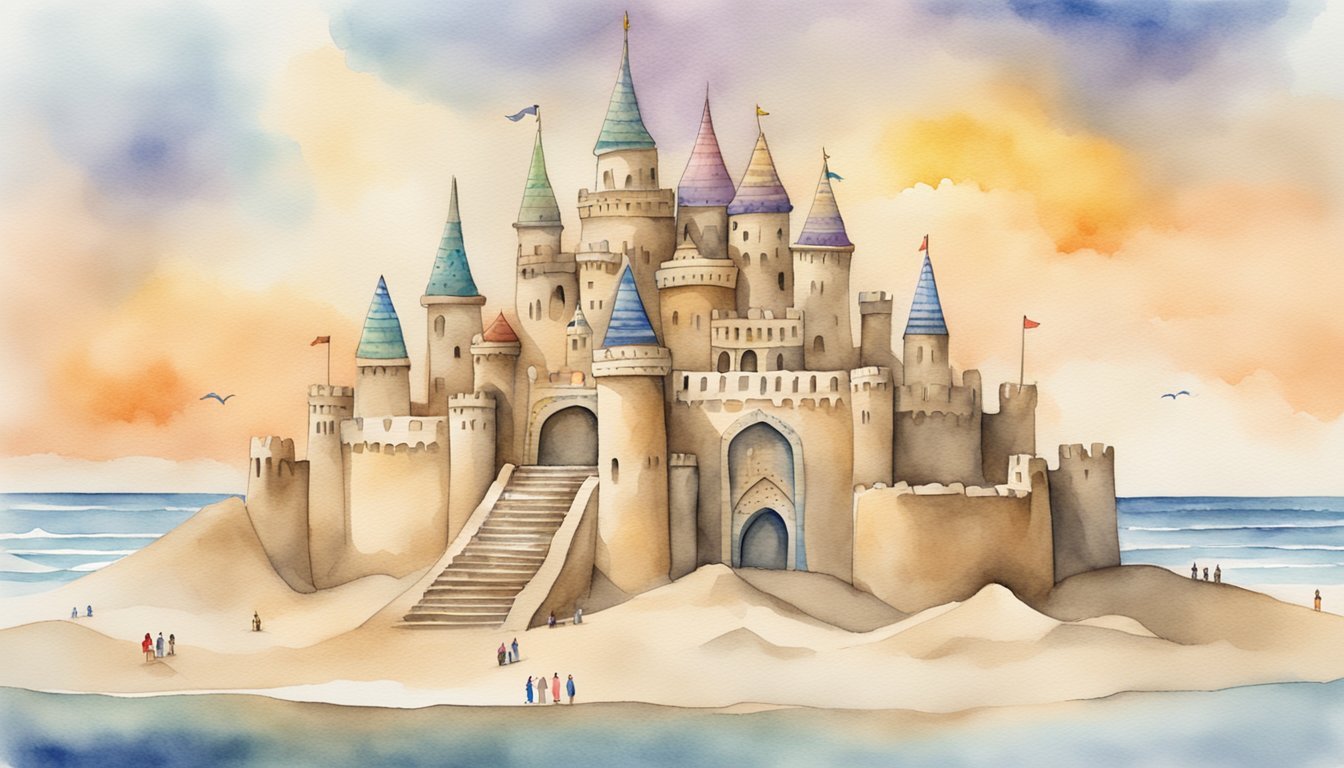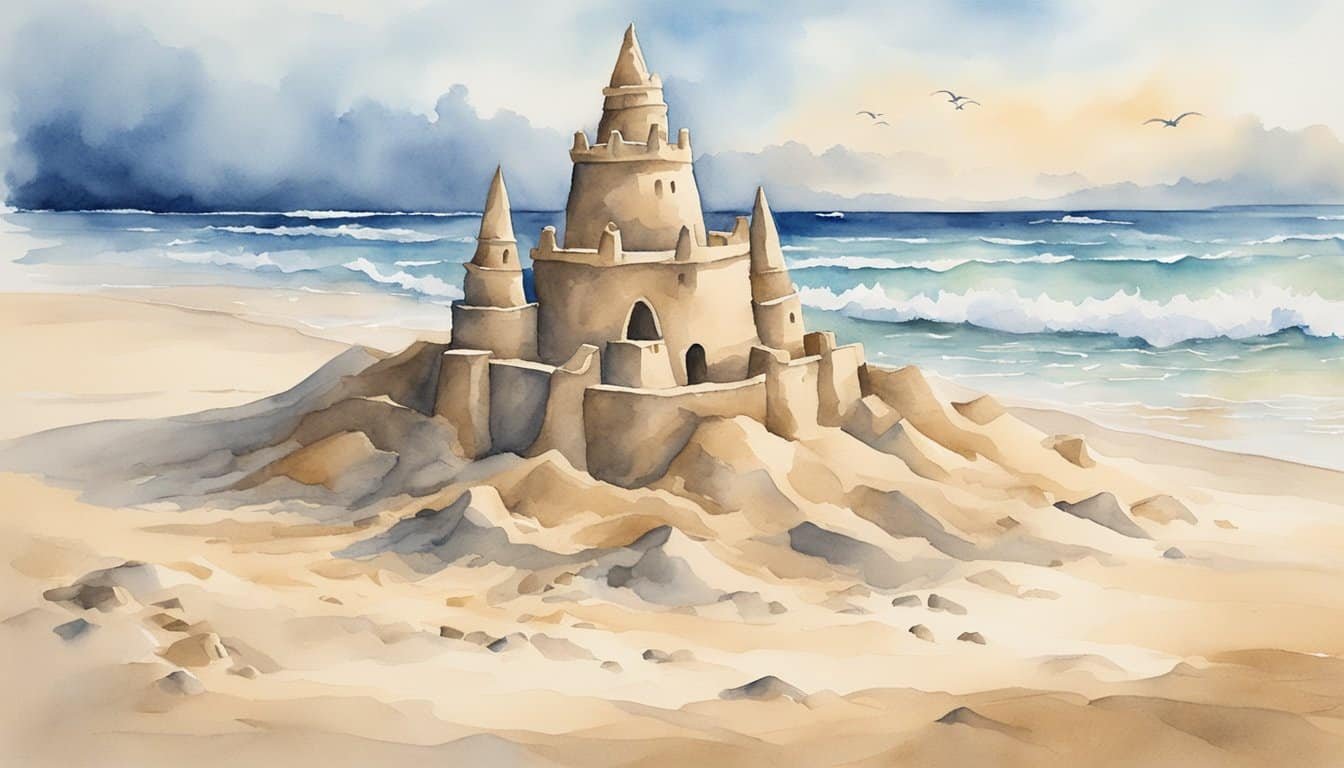Essentials of Sand Castle Building
Creating a sturdy and impressive sand castle requires specific techniques and tools. This section will guide enthusiasts on how to choose the sand, what basic tools are needed, and the techniques to construct a durable structure.
Choosing the Right Sand
The type of sand is critical in sand castle construction. The best sand for building is slightly moist and compact, as it holds shape better than dry sand. Typically, beach sand, with its mixture of shell particles and salt, sticks together well and is ideal for building a robust sand castle. Sand taken from about a foot beneath the surface often has the optimal moisture level for construction.
Basic Tools and Materials
To begin building a sand castle, one doesn’t need an extensive set of tools; a simple bucket and a spade or shovel will suffice. These tools are used to carry and shape sand. For more intricate details, plastic knives, straws, and a fine paintbrush can be useful. Carrying a spray bottle may also help to keep the sand at the right moisture level for sculpting.
Building Techniques
The technique of stacking and forming the sand determines the stability and look of the final structure. Begin with a strong foundation by filling the bucket with damp sand and flipping it upside down to create a simple tower. Carving out shapes from the tower rather than trying to pile the sand up into specific shapes is a technique often used for more advanced designs. For detail work, tools like the edge of a ruler or a small spoon can etch fine lines and create textural effects, turning a basic structure into an awe-inspiring sand castle.
Cultural Impact and Representation

Sand castles have long stood as a symbol of creativity and transience in popular culture, often capturing the imaginations of filmmakers and artists alike. Their representations in various mediums reflect societal attitudes and can profoundly influence public perceptions and artistic expressions.
Sand Castles in Film
Films often use sand castles to evoke themes such as the impermanence of life and the complexity of human endeavors. The American war drama movie Sand Castle, released on Netflix, showcases the challenges faced by American troops during the Iraq War. The movie’s title itself serves as a metaphor for the fragile nature of military occupations and the impermanence of interventionist efforts. The film’s depiction of US wars in the Middle East highlights a critical perspective on American foreign policy and its consequences.
English language movies on platforms like Netflix often include a detailed cast and crew list, from directors to screenwriters, offering viewers a glimpse into the creative minds behind the story. While release dates for films can generate anticipation, trailers provide a sneak peek, encouraging viewers to add the movie to their subscription service. Additionally, with the availability of the download feature, viewers can enjoy these dramas anytime.
Influence on Media and Art
In media and art, sand castles are a potent symbol used to inspire wonder and comment on society. They might represent childhood innocence or act as a critique of societal structures that appear mighty yet are vulnerable to the tides of change. An example includes an exploration of gender and child culture through the representation of castles in play and media, as detailed in a critical examination of these themes.
Moreover, artists and writers imbue the image of the sand castle with cultural significance, adding layers of meaning and interpretation. The visual representation in different cultural orders brings forth its ability to impact, engage, and challenge the viewer or participant in a cultural discourse. Sand castles in art can be a medium for exploring complex concepts such as temporality, creation, and destruction, reflecting broader cultural narratives.
Sandcastle: The Iraq War Movie

Sandcastle delves into the harrowing experience of a soldier and his platoon tasked with repairing a water system in an Iraqi village, offering a gritty perspective on the Iraq War’s realities.
Overview and Plot
Sandcastle is an action-packed war drama that captures the challenges faced by a young American soldier, Private Matt Ocre, played by Nicholas Hoult. The film, directed by Fernando Coimbra, portrays the unit’s dangerous mission during the invasion of Iraq. Forced into a situation far beyond their training, the platoon’s task to repair a broken water system in Baqubah is met with skepticism by both the locals and the soldiers themselves.
Real-Life Inspirations
The movie is firmly rooted in reality, inspired by the true story and script of veteran Chris Roessner, who incorporated his own experiences from the Iraq War. Scenes in Sandcastle are peppered with authentic detail that display the complexities of war, such as building trust with wary Iraqi locals while navigating the constant threat of insurgent attacks.
Casting and Character Analysis
Alongside Hoult, the film boasts a strong ensemble cast including Henry Cavill as the stoic special forces operative, Logan Marshall-Green, and Glen Powell. They play critical roles that highlight the diversity of military personnel involved in the mission. The character development across the film showcases various aspects of the soldiers’ personalities, from the leadership of Captain Syverson to the grit of the machine gunner. The interactions among the platoon members and between the soldiers and Iraqi civilians, such as those played by Sammy Sheik and Gonzalo Menendez, reflect the underlying tensions and the occasional camaraderie engendered by their shared circumstances.

